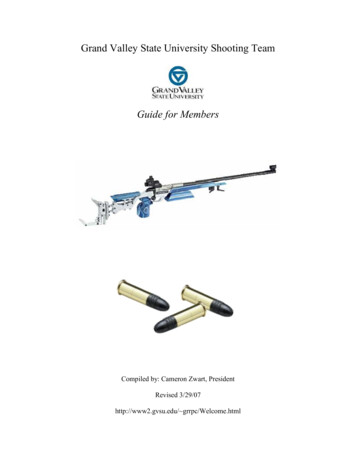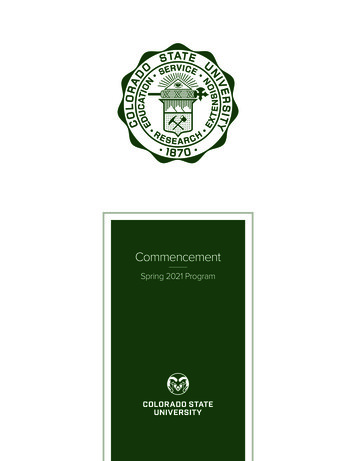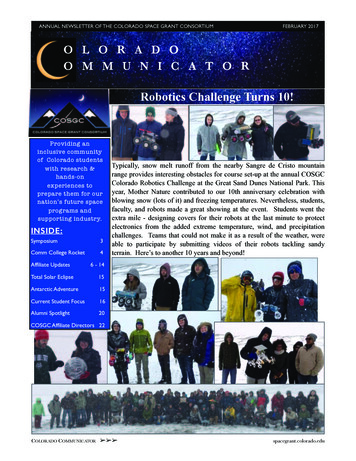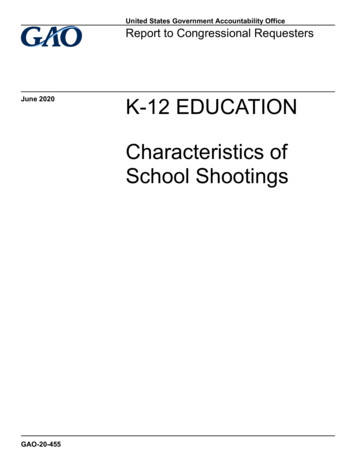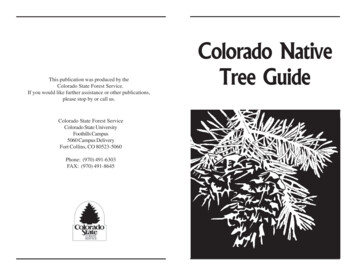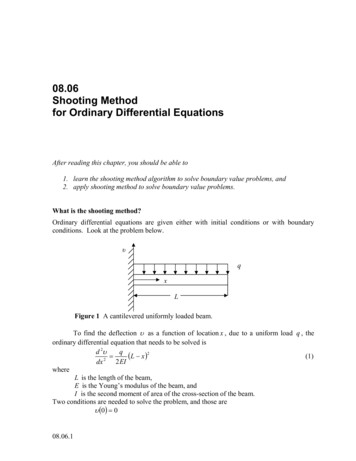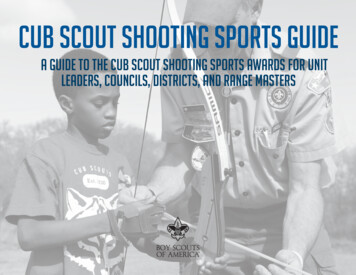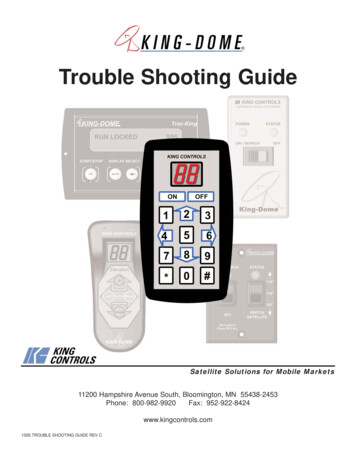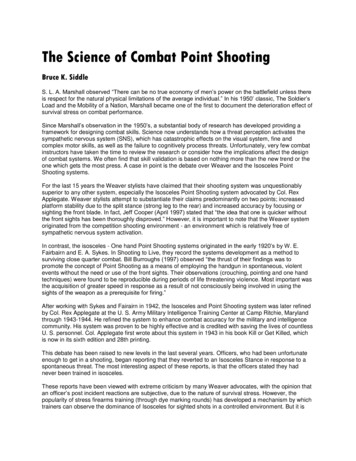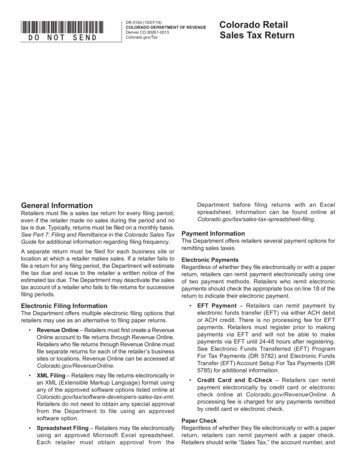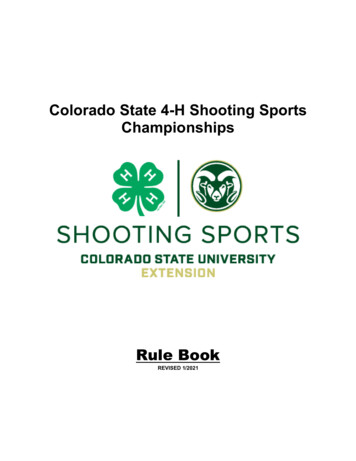
Transcription
Colorado State 4-H Shooting SportsChampionshipsRule BookREVISED 1/2021
Table of ContentsPageWelcomeState Leadership & Ambassador Team MembersState Championship Deadlines and CostsState Championship Class Entry Numbers.22 Rifle General and Range Rules.22 Rifle Scoring.22 Rifle Positions.22 Hunt Class.22 Hunt Scope.22 4-P.22 3-P.22 Rifle Illustrations.22 Rifle Targets and Placement.22 Pistol General and Range Rules.22 Pistol Scoring.22 Pistol Class Rules and TargetsAir Rifle General and Range RulesAir Rifle ScoringAir Rifle PositionsAir Rifle Utility and 4-P ClassAir Rifle 3-P and Offhand ClassAir Rifle AppearanceAir Rifle Target Placement and IllustrationsAir Pistol General and Range RulesAir Pistol ScoringAir Pistol ClassAir Pistol Target and Placement IllustrationsShotgun General and Range RulesShotgun ScoringShotgun Sporting Clays ClassShotgun Skeet ClassShotgun Trap ClassArchery General and Range RulesArchery ScoringArchery Target IllustrationsArchery ClassesMuzzleloading General, Scoring, Targets & Range RulesMuzzleloading ScoringMuzzleloading Target IllustrationsMuzzleloading ClassState Championship General Rules4-H National Championship4-H Code of Conduct4-H Dress CodeORION Scoring GuidelinesREVISED 1/20211 P a 33435363738394345464748495053545556
Colorado 4-H Shooting Sports Members, Agents, Volunteers & Parents,I want to congratulate you on being a part of the Colorado 4-H Shooting SportsProgram. Colorado 4-H shooting sports projects teach youth life skills such as decisionmaking, teamwork, self-discipline, responsibility, self-confidence, problem solving, safehandling of firearms / archery equipment and basic marksmanship. The 4-H ShootingSports program is an activity for a lifetime and is enjoyed by over 3,000 Colorado 4-HYouth each year.I am pleased to introduce the current Colorado State 4-H Shooting SportsChampionships Rule Book. This rule book will help 4-H Members, Agents, Leaders,Coaches, and Parents to better prepare for the Colorado State 4-H Shooting SportsChampionships. Please note that the Colorado 4-H Code of Conduct for both membersand adults is located at the back of the booklet, along with the dress code.The Colorado State 4-H Shooting Sports Championships are designed to promotepositive youth development and an opportunity for 4-H members who have worked hardall year long to showcase their skills. The Colorado State 4-H Shooting SportsChampionships draws over 1,000 contestants with over 4,000 entries in the differentshooting disciplines annually. I am sure that the upcoming Championships will be justas successful.4-H Shooting Sports competition serves as an evaluation of how well 4-H youth havedeveloped their skills. It is important to keep in mind the purpose and focus of our 4-HShooting Sports program - POSITIVE YOUTH DEVELOPMENT. Let’s make eachyear’s event fun, educational and safe for all who attend. Good Luck!Sincerely,Sam LowryColorado State University4-H Youth Development Specialist- Shooting Sports & Animal Science(970)-491-6225sam.lowry@colostate.eduFor more information about Colorado 4-H Shooting Sports Program, and to register for the state shootand to check results, visit www.co4hshooting.orgREVISED 1/20212 P a ge
Colorado 4-H Shooting Sports Leadership Team & Championships SuperintendentsScott Barber, Larimer CountyMichelle Butterworth, Weld CountyScott Butterworth, Weld CountyTom Coffield, Pueblo CountyGerry Ekberg, Kit Carson CountyNathaniel Ekberg, Kit Carson CountyCarla Farrand, Garfield CountyTJ Goss, Adams CountyRyan Hudson, Mesa CountyKurt Jones, Chaffee CountyTim Karp, La Plata CountyFreddie Kiefer, Larimer CountyJeff Lambeth, Las Animas CountyToni Lambeth, Las Animas CountyJohn Meyer, Adams CountyJody Lee, Moffat CountySam Lowry, State 4-H OfficeAustin Massey, Mesa CountyDale O’Donnell, Montrose CountyTodd Oppenheimer, Eagle CountyJennifer Roberts, Pueblo CountyShane Roberts, Pueblo CountyDon Simmons, Boulder CountyJack Stuart, Garfield CountyMartin Telck, Fremont CountyBrittany Van Riper, Adams CountyTom Vetter, Boulder CountyKaty Vincent, Arapahoe CountyAimee Kanode, Morgan CountyColorado 4-H Shooting Sports AmbassadorsKaitlyn Ng, Weld CountyGrace Corcoran, Pueblo CountyMontana Goodman, Morgan CountyMary Amoroso, Jefferson CountyHailey Forar, Jefferson CountyAili Gibson, Weld CountyDawson Jansson, Park CountyAbagail Richardson, Fremont CountyJessica Laffey, Larimer CountyLucas, Ng, Weld CountyDominic Richey, Elbert CountyAllyson Neal, Pueblo CountyRyer Roberts, Mesa CountyThe Colorado 4-H Shooting Sports Ambassadors are a diverse and united group of Colorado 4-Hmembers who are dedicated in providing leadership and knowledge to 4-H youth throughShooting Sports with an emphasis on positive youth development, safe inclusive environments,and promoting integrity.REVISED 1/20213 P a ge
COLORADO STATE 4-H SHOOTING SPORTSCHAMPIONSHIPS REGISTRATIONS DUE:5:00 PM August 1, of the current 4-H yearAll questions regarding registrations should besubmitted via email to co4hshooting@gmail.comRegistration and class fees are as follows:Registration Fee: 20.00 per registeredparticipant.All Non-Shotgun Class Fees: 5.00 per class perregistered participant.All Shotgun Class Fees: 15.00 per class perregistered participant.Edits or cancellations of registrations that are in prior to the registrationdeadline are due by 5:00 PM August 6th of the current 4-H Year.NO refunds will be given for registration cancelations after5:00 PM August 6.Issued in furtherance of Extension work. Acts of May 8 and June 30, 1914 in cooperation with the U.S. Department of Agriculture.Extension programs are available to all without discrimination. To simplify technical terminology, trade names of products andequipment will occasionally be used. No endorsement of products named is intended nor is criticism implied of products notmentioned.REVISED 1/20214 P a ge
Colorado 4-H Shooting SportsState 4-H Shooting Sports ChampionshipsClass Number List2) Senior Division1) Junior Divisiona) .22 Riflei) 50’ Huntii) 50’ Hunt Scopeiii) 50’ 4-P Sporteriv) 50’ International 3-Pb) .22 Pistoli) Pistolc) Air Riflei) 25’ Utilityii) 10M 4-P Sporteriii) 10M Precision 3-Piv) 10M Olympic Off-Handd) Air Pistoli) 10M Pistole) Shotguni) Sporting Claysii) American Skeetiii) Trapf)Archeryi) Compound Unlimitedii) Compound Limitediii) Compound Traditionaliv) Recurve Limitedv) Recurve Traditionalg) Muzzleloadingi) MuzzleloadingREVISED 1/2021100102104106a) .22 Riflei) 50’ Huntii) 50’ Hunt Scopeiii) 50’ 4-P Sporteriv) 50’ International 3-P101103105107108b) .22 Pistoli) Pistol109200202204206c) Air Riflei) 25’ Utilityii) 10M 4-P Sporteriii) 10M Precision 3-Piv) 10M Olympic Off-Hand201203205207208d) Air Pistoli) 10M Pistol209300302304e) Shotguni) Sporting Claysii) American Skeetiii) Trap301303305f)400402404406408Archeryi) Compound Unlimitedii) Compound Limitediii) Compound Traditionaliv) Recurve Limitedv) Recurve Traditionalg) Muzzleloadingi) Muzzleloading5005 P a ge401403405407409501
.22 Rifle General Rules1.2.3.4.5.6.7.8.9.10.11.12.13.Inspection: There will not be an inspection/weigh-in station. It is theresponsibility of each shooter and their coaches to ensure the rifles they will be usingduring the competition meet the rules listed in the State Contest Rulebook. There willbe a scale and barrel measuring device available all day for contestants to use if theywish to check their rifles prior to the relay. There will be random checks of riflesconducted on the ranges all day during the contest. Any rifles found not meeting thelisted specifications will be disqualified and the scores earned during that relay will beforfeited. The random checks will be made by the Superintendent or their designee.The range officer on that relay will assist with the checks. If the rifle fails, this will benoted on the targets so appropriate action can be taken in the scoring process.Firing Line: No portion of the competitor’s body may rest upon or touch the groundin advance of the firing line or be more than six (6) inches behind the firing line.Clear Bore Indicators (C.B.I.’s): All competitors will use C.B.I.’s that are requiredto extend a minimum of three (3) inches past the muzzle and the action when notfiring, they may be any color.Eye Protection: All competitors and other personnel in the immediate vicinity ofthe ranges are to wear eye protection.Ear Protection: All competitors and other personnel in the immediate vicinity ofthe ranges are to wear hearing protection.Clothing: Shooting coats, shooting jackets, shooting gloves, shooting pants, andshooting shoes are prohibited in most classes. Any exceptions to this rule will benoted in the specific class rules.Spotting Scopes: Spotting scopes or binoculars will be allowed throughout the match.Spotting Scope bases may be ahead of the firing line, however, the eyepiece of thespotting scope must remain behind the firing line.Sling: The use of a sling is not allowed in most classes. Any exceptions to this rulewill be noted in the specific class rules.Sight Definitions: Open: A combination of an open notch (rear) and blade or post(front) sight. A factory installed hood on the front sight will be allowed. No lenses.Aperture: Must have a rear peep and front aperture. Interchangeable apertureinserts are allowed. No lenses.Kneeling Rolls: Kneeling rolls will be permitted in all classes. Kneeling rolls are tobe used in the kneeling position only. They are to be made of a pliable materialnot to exceed seven (7) inches in diameter by nine and one-half (9-1/2) inches inlength.Artificial Shooting Rests & Supports: Bi-pods or leaning devices may be used tosupport the firearm when at rest only and not during the shooting sequence. Riflerests may be placed ahead of the firing line. No other type of supports will beallowed.Shooting Mats: Shooting mats are not to exceed one (1) inch in thickness, inaddition to ground cover provided. Youth are to provide their own shooting mats.Coaching: Coaching is permitted during the sight-in period only. The coach mayassist the competitor during this time by calling the shots, checking time, checkingscore, ordering sight changes, etc., but may not physically assist the competitor inloading, cocking*, adjusting positions or making sight corrections. The coach mustcontrol their voice and actions as not to disturb other competitors. A competitor mayhave no more than one (1) coach on the line during the sight-in period. Coaching willnot be allowed from the spectator area.*A competitor may have assistance withthe cocking of the firearm with prior approval of the superintendent.REVISED 1/20216 P a ge
14.15.16.17.18.19.20.Magazines: Extended capacity magazines protruding more than on (1) inch belowthe firearm are prohibited. Protruding magazines may not be used as a support.Action Open: Unless cased, all actions are to remain open.a. No competitor will aim toward the targets until the proper command is given.b. No firearm will be handled in any manner to violate any safety rule.Cased Firearms: Firearms are to remain cased until reaching the designated stagingarea or firing line.Firearms Unloaded: The firearm may not be loaded until the competitor hastaken position at his or her firing point, firearm pointed toward the target and thecommand has been given. Only one (1) cartridge or pellet may be loadedat any time. Competitor must only load one cartridge or pellet in a clip ormagazine at a time. A clip or magazine may only have one cartridge or pellet in itat any time.Cease Fire: All firearms will be unloaded immediately upon the command “Cease Fire.”Actions will remain open and chambers up.Discipline: The safety of competitors, range personnel and spectators requires all togive continuous attention to careful handling of firearms and caution while movingabout the range.Delaying a Match: No competitor may delay the start of the match through tardinessin reporting or undue delay in preparing to fire.Range Commands1.2.3.4.5.6.7.8.Firing Line Commands: The following commands will be used. Adjustments maybe made to the time allotment for each shooting period based on the block timesused in the competition.Competitors to the line: Competitors may bring equipment and rifles to the line.Rifles are to have actions open and up. Adjustments will be made during the sight-inperiod.Your five (5) minute sight-in period begins now: Competitors may live fire riflesat sight-in target and make any necessary adjustments. Coaches are permitted toinstruct how to make sight adjustments, but may NOT physically make suchadjustments. Any and all adjustments must be made by the competitor.Cease Fire: All shooting stops after the sight-in period. Range personnel will godown range with the permission of the range official to mark errant shots. Coacheswill be excused from the firing line.You will now have 40 minutes for to record your shots: Commence Firing.Competitors will have the allotted time to shoot record shots. (See Course of Fire inindividual contest rules.) When competitors are finished, rifles are to remain groundedwith actions open and up. Competitors are to remain on the line until the block of timeis completed or they are instructed to leave the line.Cease Fire. After the allotted time, or at any time the range official deems necessary,the cease fire command will be given. All rifles will be grounded with actions open andup. Firing must cease immediately.Competitors may remove equipment from the line. Upon hearing this command,competitors may remove equipment from the line at this time. Range personnel willcollect targets and transport them to the scoring location.Note: Block time will be used whenever possible. Notice will be given the day of thecompetition. A five-minute warning for the end of the relay will be announced.REVISED 1/20217 P a ge
Equipment1.2.3.4.5.6.7.AR or Modern Sporting type firearms will NOT be allowed. Any rifle, pistol or shotgunthat is primarily tactical in design and strongly resembles an AR, modular or modernsporting firearm type platform rifle will be removed from the firing line.Suppressors are not permitted.Any type .22-caliber rifle capable of loading one (1) round at a time is allowed.Single-shot bolt action or lever action rifles are preferred, however, any action typemay be used if it can be demonstrated that it can be loaded one (1) round at a time ina safe manner. Detachable magazines protruding no more than one inch form thestock of the rifle are allowed to be used if the shooter cannot easily load one round ata time into the chamber. (Example: a Ruger 10/22, or a semi-auto) Tubularmagazines are permitted but must be loaded one round at a time.It is up to the competitor to have the rifle approved before competing.Ammunition: Ammunition that is commercially manufactured, solid point, standard,high or target velocity, cataloged as .22 short, long or long rifle ammunition is required.No .22 magnum caliber allowed. No hollow point, hyper velocity (1,400 fps ),incendiary or tracer ammunition will be permitted.No set or electric triggers are allowed.Any safe trigger is allowed. A safe trigger is one which does not allow the hammer orfiring pin release to fall except by a deliberate pull of the trigger by the competitor.Sights, optics or shooting aids that project any type of light, image or laser down rangeare prohibited unless otherwise specified.Scoring1.2.3.4.5.6.7.Sight-in: Must be shot at the sighter target only. The sighter is the center bull on 1sttarget shot, prone position.Targets must be shot in the following order: Prone, Standing, Kneeling, SittingMultiple shots in one bull: The competitor will receive the lowest score on the bull. Thishas no effect on excessive hits on target.Excessive shots on a target – i.e. - 11 shots on a 10 bull target: From the back side ofthe target count total number of holes. If the total number of holes is more than thecourse of fire dictates, the competitor will lose the highest scoring shot of the target foreach excessive shot on the target.Cross Fires: Defined as one competitor’s shot to another competitor’s target. All crossfires must be reported to the line official immediately, before the allotted relay timeexpires. The line official must sign off on all cross fires or they will be scored asexcessive shots.Internal hits on wrong target: The Shooter shall call excessive shot on target and itmust be noted on the target by the line official, The Shooter should not shootanother shot at the correct target. The shooter will only lose the points formultiple shots on bull. If the shooter chooses to reshoot the bull they will beassessed the penalty for excessive shots on target.Tie Breaker: a. Total standing target scoreb. Total kneeling target score (4-P)c. Total prone target scored. Total sitting target scoreIf additional tie breakers are necessary, it will continue with the most 10’s on eachof the targets in the order given above.REVISED 1/20218 P a ge
Rifle PositionsStandingKneelingAdapted from NRA Smallbore rifle rules. Note theposition of the kneeling roll.Kneeling: The non-dominant elbowis placed on or over the upright knee.The elbow is defined as 4” from thepoint of the arm when bent. TheKnee is defined as the bent part ofthe Knee (i.e. knee cap). Arms maynot be wrapped around legs, butrather supported by contact of elbowto kneeProneSittingAdapted from NRA Smallbore rifle rules.Adapted from NRA Smallbore rifle rules.Adapted from NRA shooting positions poster.Sitting: Weight of the body supportedon the buttocks and the feet or ankles,no other portion of the body touchingthe ground. The rifle will be supportedby both hands and one shoulder only.Elbows may rest on the legs at anypoint above the ankles. (The elbow isdefined as 4 inches from the point ofthe arm when bent.REVISED 1/20219 P a ge
.22-Rifle 50-Foot Hunt Class Rules1.2.3.4.5.6.7.Open sights or fiber optic neon enhancement sights and factory installed hooded frontsights are allowed. Aperture sights and front aperture sights are not allowed.All rifles must have the appearance of a standard hunting rifle with a maximum outsidebarrel dimension of .675 inches at the widest point of the muzzle.Rifles must have a factory-type stock (wood or plastic) which may be altered for lengthonly. No other alterations will be allowed. No skeletonized stocks or modular typestocks will be allowed.No heavy or varmint style barrels will be allowed.Adjustable or hook-type butt plates are prohibited.Thumb hole stocks, palm rests and heel rests are prohibited.The weight of the complete rifle with sights may not exceed 7.5 pounds in weight. Riflesmay be reweighed at any time by superintendent or designee. Consequences mayresult in score disqualification.Course of Fire:Ten (10) shots in each of the following positions in the following order.Sight in middle bull on prone targetProne bottom leftStanding top leftKneeling top rightSitting bottom rightTime:Sight-in period 5 minutesRecord Shots Period 40 minutesTargets used:ORION 50ft Conventional Rifle12 Bull Target or NRA A-17Following the sight-in period, range personnel will go down range to check for and mark errantsight-in shots. The same time will be allotted to both junior and senior competitors. Block timewill be used.REVISED 1/202110 P a g e
.22-Rifle 50-Foot Hunt Scope Class Rules1.2.3.4.5.6.7.8.A fixed 4X magnification telescopic sight or a variable magnification telescopic sight(set at a maximum of 4X magnification) with a maximum body tube diameter of one(1) inch shall be used. Variable magnification scope must be locked and/or taped to amaximum of 4X magnification during competition. Once set, the scope magnificationcannot be changed during competition.Red dot or aim-point type sights that do not project any type of light or laser downrange and are no more than 4X magnification may be used.Open iron sights/open fiber optic sights or aperture sights with front aperture may bemounted on the rifle, but not used during the competition. “See through” scopemounts (if present) will be taped closed.All rifles must have the appearance of a standard hunting rifle with a maximumoutside barrel dimension of .675 inches at the widest point of the muzzle.Rifles must have a factory-type stock (wood or plastic) which may be altered forlength only. No other alterations will be allowed. No skeletonized stocks ormodular type stocks will be allowed.No heavy or varmint style barrels will be allowed.Adjustable or hook-type butt plates are prohibited.The weight of the complete rifle with scope may not exceed 7.5 pounds in weight. Riflesmay be reweighed at any time by superintendent or designee. Consequences may resultin score disqualification.Course of Fire:Ten (10) shots in each of the following positions in the following order.Sight in middle bull on prone targetProne bottom leftStanding top leftKneeling top rightSitting bottom rightTime:Sight-in period 5 minutesRecord Shots Period 40 minutesTargets used:ORION 50ft Conventional Rifle12 Bull Target or NRA A-17Following the sight-in period, range personnel will go down range to check for and mark errantsight-in shots. The same time will be allotted to both junior and senior competitors. Block timewill be used.REVISED 1/202111 P a g e
.22 Rifle 50-Foot 4-Position Sporter Class Rules1.2.3.4.Peep type aperture sight front and rear. No open sights, red dot sights, aim-point typesights or scopes allowed.The length of stock, height of cheek piece and butt plate location may not bechanged after the five (5) minute sight-in period.Thumb hole stocks, palm rests, heel rests, Scheutzen-type and hooked-type buttplates are prohibited.The weight of the complete rifle with sights may not exceed 8.5 pounds in weight. Riflesmay be reweighed at any time by superintendent or designee. Consequences may resultin score disqualification.Exceptions to General .22-Caliber RulesClothing: Shooting gloves are permissible. Shooting coats, shooting jackets, shooting pantsand shooting shoes are prohibited.Sling: A sling may be used for all positions except the standing position.Rifles in this class may also qualify for the International 3-Position class. All rifles must have theappearance of a sporter rifle.Course of Fire:Ten (10) shots in each of the following positions in the following order.Sight in middle bull on prone targetProne bottom leftStanding top leftKneeling top rightSitting bottom rightTime:Sight-in period 5 minutesRecord Shots Period 40 minutesTargets used:ORION 50ft Conventional Rifle12 Bull Target or NRA A-17Following the sight-in period, range personnel will go down range to check for and mark errantsight-in shots. The same time will be allotted to both junior and senior competitors. Block timewill be used.REVISED 1/202112 P a g e
.22 Rifle 50-foot International 3-Position Class Rules1.2.3.4.Peep-type aperture sights front and rear. No open sights or scopes allowed.Hook butt plates are allowed. Wrap-around body hooks are not allowed.No weight limit.All rifles must have the appearance of a sporter rifle.Exceptions to General .22-Caliber RulesClothing: Shooting coats or jackets and gloves are mandatory. Shooting pants and shoes areoptional. Jacket or coat must include pads not to exceed three-fourths of an inch (3/4) inthickness attached to the outside of the jacket. The location of the pads is to be at the shoulderfor the butt plate and on the elbows. Sleeves are to be no longer than the wrist. Jacket or coatlength is to be no longer than the fingertip with arms hanging to the side of the body.Sling: A sling may be used for all positions except the standing positionCourse of Fire:Ten (10) shots in each of the following positions in the following order.Sight in middle bull on prone targetProne bottom leftStanding top leftKneeling top rightTime:Sight-in period 5 minutesRecord Shots Period 40 minutesTargets used:ORION 50m Rifle reduced for 50ft 12 Bull Target NRA A-36Following the sight-in period, range personnel will go down range to check for and mark errantsight-in shots. The same time will be allotted to both junior and senior competitors. Block timewill be used.REVISED 1/202113 P a g e
Rifle Illustrations Conventional Appearance.22 Hunt Rifle.22 Sporter RifleRifle Sight IllustrationsFront ApertureHooded Front SightRear Peep / ApertureREVISED 1/202114 P a g e
.22 Rifle Target PlacementPlacement for Hunt, Hunt Scopeand 4-P Sporter classes.StandKneelProneSittingPlacement for International3 Position classStandKneelProne.22 Rifle Target IllustrationsORION 50ft Conventional Rifle12 Bull TargetNRA A-17ORION 50m Rifle reduced for 50ft 12 Bull TargetNRA A-36REVISED 1/202115 P a g e
.22 Pistol General and Range RulesGeneral Rules1.4-H Members must be 9 years old as of the start of the current 4-H year. Members musthave at completed at least one project year of 4-H Shooting Sports that includes live firerange experience with a firearm or air gun. Each county may have more requirements toparticipate in this project.2.Members must have written permission from parent or legal guardian to participate inthis project in compliance with the Gun Control Act of 1968 and the Youth HandgunSafety Act of 1994.3.The Youth Safety Handgun Act, as included in the Gun Control Act of 1968, putsrestrictions on the use and possession of handguns by youth under 18 years of age.Youth participating in Colorado State 4-H Shooting Sports Invitational must, at all times,follow all provisions of this act. Therefore, event officials will require “the prior writtenconsent of the juvenile’s parent or guardian who is not prohibited by Federal, State, orlocal law from possessing a firearm.” This written permission must be in possession ofthe youth – even if a parent/guardian is present. Please follow this link to the ColoradoState 4-H website for a copy of this Handgun-realese-form-fillable.pdf.4.This document must be available upon request at check-in.5.All small bore .22 pistols are required to use a CBI (Clear Bore Indicator) when thehandgun is uncased and not being fired.6.Ammunition: Ammunition that is commercially manufactured, solid point, standard, highor target velocity, cataloged as .22 short, long or long rifle ammunition is required. No.22 magnum caliber allowed. No hollow point, hyper velocity (1,400 fps ), incendiary ortracer ammunition will be permitted.7.Cased pistols will be the last equipment to be brought to the range and the first to beremoved from it.8.All are “single pistol” matches, meaning participants are to shoot the entire course of fire,with the same pistol. No pistol changes will be allowed between stages, and only onepistol per shooter is allowed on the line. Pistols may be replaced only if they aredisabled or malfunctioning.9.22 Pistol Events: There will not be an inspection/weigh-in station. It is the responsibilityof each shooter and their coaches to ensure the pistols they will be using during thecompetition meet the rules listed in the State Contest Rule Book. There will be a scaleand barrel measuring device available all day for contestants to use if they wish to checktheir pistols prior to the relay.10.There will be random checks of pistols conducted on the ranges all day during thecontest. Any pistol found not meeting the listed specifications will be disqualified and thescores earned during that relay will be forfeited. The random checks will be made by theSuperintendent or his designee. The range officer on that relay will assist with thechecks. If the pistol fails, this will be noted on the scorecards so appropriate action canbe taken in the scoring process.11.Each shooter will compete in both matches. Two relays in a row (2 hours total) arerequired to compete in this event, please schedule your time accordingly.12.Action Open: Unless cased, all actions are to remain open.13.No competitor will aim toward the targets until the proper command is given.14.No pistol will be handled in any manner to violate any safety rule.15.Cease Fire: When the command “cease fire” is given, all pistols are to be benched andunloaded, with actions open. Any competitor with ammo chambered at the time of thecease fire command will alert the line official. Competitors are to await further instructionfrom the range official.REVISED 1/202116 P a g e
16.Firearms Unloaded: The firearm may not be loaded until the competitor has takenposition at his or her firing point, firearm pointed toward the target and the command hasbeen given.17. AR or Modern Sporting type firearms will NOT be allowed. Any rifle, pistol or shotgun that isprimarily tactical in design and strongly resembles an AR, modular or modern sportingfirearm type platform rifle will be removed from the firing line.18. Suppressors are not permitted.Alibi Procedures1.Only one alibi will be allowed in each course of fire during the match (one alibi permodified Camp Perry course of fire and one alibi per silhouette course of fire). Any alibiclaim made that a pistol or ammunition is malfunctioning must be made immediately. Allshots fired up to the time of the alibi claim is made will stand as part of the official score.The contest superintendent will determine the shots under consideration for alibiprocedures upon notification of the alibi claim.2.The Chief Range Officer or designated Range Officer should pause 3 seconds andannounce, “ARE THERE ANY ALIBIS?” If none are indicated by the line officers orcompetitors, the Chief Range Officer or designated Range Officer will then command,“ACTIONS OPEN; INSERT CLEAR BORE INDICATORS; SHOOTERS, MAKE THELINE SAFE.”Range Alibi or Interruption of FireA range alibi or interruption of fire occurs when a competitor, group of competitors or relay ofcompetitors are prevented from firing or completing a series due to a fault of the rang
The Colorado State 4-H Shooting Sports Championships are designed to promote positive youth development and an opportunity for 4-H members who have worked hard all year long to showcase their skills. The Colorado State 4-H Shooting Sports Championships draws over 1,000 contestants with over 4,000 entries in the different
